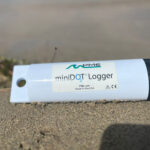
Harnessing Marine Microclimates
October 22, 2019
Studying the Environmental Parameters and Fauna of Underwater Caves
December 2, 2019Oxygen Supersaturation Protects Coastal Fauna from Ocean Warming
Project Details
- PRODUCT(S): miniDOT® Logger
- APPLICATION: Coastal / Ocean
- PARAMETER: Dissolved Oxygen, Temperature
- LOCATION: Red Sea
- ORGANIZATION: East Bay Regional Parks District
- RECOGNITION: Folco Giomi, Alberto Barausse, Carlos Duarte, Jenny Booth, Susana Agusti, Vencent Saderne, Andrea Anton, Daniele Daffonchio, Marco Fusi
Case Study Description
Warming ocean water can stress fish and other aquatic animals, sometimes to the point where organismal survival is threatened. The mechanism by which this occurs is well understood. A rise in water temperature causes an increase in animal metabolism, increasing the rates of, and need for, respiration, while at the same time reducing the supply of dissolved oxygen. Thus, in a warming scenario, fish (and other animals) need more oxygen and are trying to draw it from a (sometimes dramatically) reduced supply. The result can be fishkill, sometimes of catastrophic proportions.
With global climate change causing a general warming of the world’s ocean waters, scientists, conservationists, and fisheries managers are alarmed by the prospect of long-term damage to the stocks of many aquatic species.
A Resistant, Resilient Planet
A recent study by Red Sea researchers Folco Giomi, Alberto Barausse, Carlos Duarte, Jenny Booth, Susana Agusti, Vencent Saderne, Andrea Anton, Daniele, Dffonchio, and Marco Fusi, however, may indicate a more optimistic view is in order. The ocean, the researchers found, may be more resistant and resilient to climate change than was previously thought.
Giomi, et al., found that the increased metabolic demand imposed by warming waters and declining dissolved oxygen levels can, in many cases, be fulfilled by photosynthetically induced hyperoxia, expanding the thermal tolerance for many species. Warming waters, they found, cause an increase in photosynthesis, which produces dissolved oxygen (DO). Sometimes, if the warming is significant enough, the resulting increase in DO can rise to the level of supersaturation, providing enough new DO to meet the increased respiratory demands of fish and other aquatic animals.
Materials and Methods
Giomi, et al., conducted their research in the Red Sea, which is the warmest sea on earth and one that is warming faster than the global oceanic average. They employed a unique high-frequency monitoring dataset of dissolved oxygen concentration and water temperatures, taken at 5-minute intervals in seagrass meadows, coral reefs, and mangrove stands, the three most prevalent biogenic habitats in the Red Sea.
In these locations, they moored multiparametric probes equipped with calibrated conductivity, water temperature, depth, and dissolved oxygen concentration (optical) sensors CTD-O2 by Exosond. To support data retrieved by these probes, they deployed PME miniDOT loggers at 1 to 2 cm from the sediment surface. Data from the miniDOTs consistently showed the same pattern detected by the probes.
To determine the effects of warming and resultant supersaturation on local fauna, the team sampled six different animal species from four different phyla. They transferred collected individuals to aquarium facilities where, after resting them to negate the effects of handling and transport, they exposed half of the animals to normoxic conditions and the other half to hyperoxic conditions for two hours before the start of a temperature ramping of one degree every thirty minutes, mimicking Red Sea environmental temperature fluctuations. The animals’ mortality was observed and recorded along with oxygen consumption, lactate concentration and environmental oxygen pressure.
Since the installation of the hypolimnetic oxygenation system, Culver’s team has determined that 5mg/L of O2 is the ideal level of augmentation to encourage decomposition in the deepest levels of the lake while remaining hospitable to resident fish. Such oxygenation systems are more commonly found in larger bodies, particularly those used for drinking water, but the success seen by East Bay Regional Park may only be the first of many to come. While Culver imagines the detritus built up at the bottom of Lake Anza, the early success shown by the miniDOT® data is on track to continue its positive trend.
Conclusion
PME’s miniDOT logger is a completely submersible instrument that measures dissolved oxygen (DO) and temperature. The oxygen sensor is an optode that measures DO concentration through a fluorescence method. Data are recorded to an internal SD card. Operational adjustments such as setting the time and sample interval can be accomplished through the USB cable. An optional anti-fouling device is available.
For more information on how PME products might assist with your research project(s), contact us.
Product Description
The miniDOT® Logger is a completely submersible instrument that logs dissolved oxygen and temperature measurements. Data is recorded on the internal SD card and operational functions, like setting time and sample intervals, can be accomplished via USB cable. The oxygen sensor is an optode that measures dissolved oxygen concentration in water through a fluorescence method. The miniDOT® can withstand temperatures ranging from 0 – 35°C with a depth rating of 300 meters.

